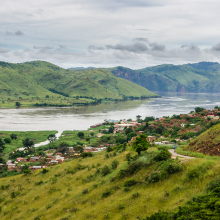The Congo Basin plays a key role in the global water and carbon cycle: It is the second largest river system on earth after the Amazon basin. The dense rainforest that covers most of the region is home to an extraordinarily high biodiversity and also acts as a carbon sink. The Congo Basin stores about as much CO2 as humanity currently emits in 30 months. "Despite the enormous ecological importance of the Congo Basin, the complex hydrological relationships in the region have barely been explored," says Dr. Mohammad Tourian of the Institute of Geodesy at the University of Stuttgart.
Originalpublication
Mohammad J Tourian, Fabrice Papa, Omid Elmi, Nico Sneeuw, Benjamin Kitambo, Raphael M Tshimanga, Adrien Paris, Stéphane Calmant (2023) Current availability and distribution of Congo Basin’s freshwater resources. In: Communications Earth & Environment, Volume 4, Article number 174, 22 May 2023
Determining water catchments using satellite images
Working with international researchers, Tourian has for the first time provided solid estimates of how much drainable freshwater is stored throughout the Congo Basin and how these resources are distributed regionally. According to the study, published in the Nature journal Communications Earth & Environment, the 3.7 million-square-kilometer area contains a water catchment area of about 490 cubic kilometers. This corresponds to about ten times the volume of Lake Constance. "Sixty-three percent of the water resources are stored in the southernmost Kasaï and Lualaba catchments," Tourian says. "The northern areas are not as water-rich, although the swamp forests of Cuvette Centrale are the largest tropical peatlands in the world. We were very surprised by this uneven regional distribution."
For their calculations, the researchers combined water level gauges provided by the University of Kinshasa in the Democratic Republic of Congo with satellite images, altimetry, and data from the Gravity Recovery and Climate Experiment (GRACE) and the follow-up mission GRACE-Follow-on. The two GRACE satellites have been precisely measuring spatial and temporal variations in the Earth's gravitational field since 2002.
Because seasonal effects such as rainy and dry seasons cause significant changes, the data can be used to draw conclusions about water storage in large areas.
"However, the satellites cannot see whether the water is groundwater or water in lakes or wetlands," explains Tourian. While groundwater reservoirs and soil moisture primarily contribute to the river system, natural lakes and swamps in the Congo Basin can store and release water independently of the river flow, even over long periods of time. "The amount of drainable water is therefore mainly a variable of groundwater and soil moisture," explains Tourian.
For their calculations, the researchers subtracted temporal variations in lake and wetland water storage from temporal variations in total water storage for each subbasin. By examining the relationship between the results and the average monthly runoff from the Congo River to the Atlantic Ocean, they were able to determine total water storage.
Securing the regional water supply
Tourian used the same method to estimate water storage in the Amazon Basin in 2018, for which he received the University of Stuttgart's publication award the following year. "Current gauges are available for the Amazon, while on-site measurements (in situ data) are outdated for the Congo Basin," he acknowledges. However, he said, the results are so plausible that it is reasonable to assume that the Congo's discharge has changed little over the decades.
The researchers estimated the hydraulic time constant for draining the water reservoir in the entire Congo Basin to be just over four months. "However, the fact that the lakes and wetlands act as resistors leads to much larger time constants in some subregions: For the Lualaba-Lukuga region, where Lakes Tanganyika and Kivu are located, we estimate it to be around 105 months," said Tourian.
The study provides important insights into water availability in the Congo Basin, that is, the amount of freshwater available per person per year. The population of around 120 million people is expected to double within a few decades. Land use and deforestation are already threatening water resources. In the future, mean annual runoff could increase by up to 20 percent as a result of climate change. "Especially in rural areas, there are major challenges related to water security," Tourian says. Based on the estimates, governments and regional authorities, as well as international institutions such as the World Bank or the United Nations Development Programme (UNDP), can now develop long-term strategies to optimally use and protect water resources in the Congo Basin.
Services around publishing
The team of the University Library gives advice on funding issues and publication opportunities, including the publishing of books. It is important to contact the team at an early stage, especially in the case of projects of the German Research Foundation.
Contact:
Stefan Drößler, Open Access Officer, phone: +49 711 685-83509, E-mail.
Further information and advice.
The following institutions (among others) will be happy to help you with writing scientific texts:
If you have recently published a paper that would be suitable for presentation as part of the Publizieren! series, please send a brief summary of the topic to University Communications and give a reason why the paper should be included in the series.




